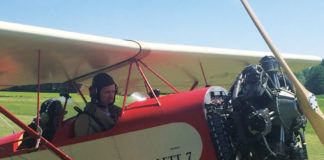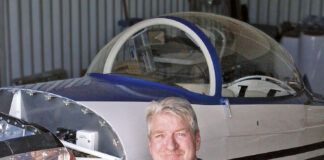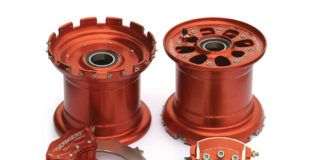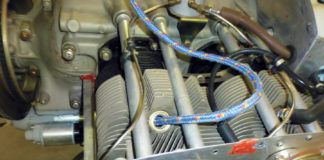The Southwest Airlines jet, luckily a Boeing 737, bounced along on a delayed final approach into Orlando International Airport, heavy crosswinds making a smooth touchdown improbable. As I later drove my rental car north from the airport, palm fronds and tree limbs littered the street. The winds, rain, thunder and lightning continued through the night and into the next day. With power off for two days, I spent nights on my host’s office sofa bed, reading James Hansen’s Storms of my Grandchildren by the glimmer of a small flashlight, imagining how bad future downpours could be as the earth warms and the air becomes more saturated, a prediction in the noted climate scientist’s book.
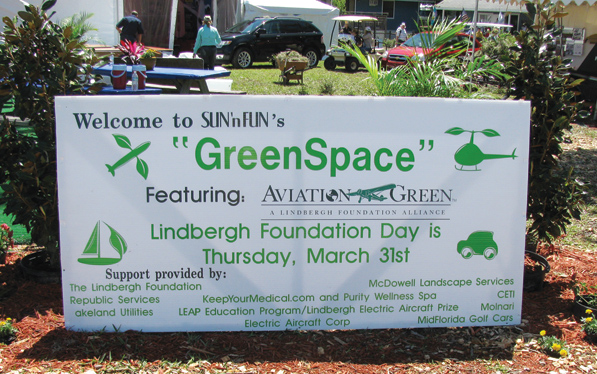
The Lindberghs’ influence was much in evidence at the SNF Green Space area.
Thursday didn’t dawn so much as prove only moderately lighter than the night. My host John MacKay and I decided that thunderstorms sweeping across central Florida made a trip to Lakeland and Sun ‘n Fun 2011 unwise for the moment. Another day of donner und blitzen followed, but Friday brought a sunny, cloudless day and long lines into the airshow. Parking was slogged by the muck left from the previous day’s storms and an F1 tornado that destroyed as many as 69 aircraft and left the field littered with the twisted remnants of display tents. Despite that, the show crew, mostly volunteers, had done a yeoman job in clearing the debris and making a nearly pristine display area.
The Green Aviation exhibits were packed in a small patch of a sprawling area, but gave ample evidence of commitment and vision in the emerging field.
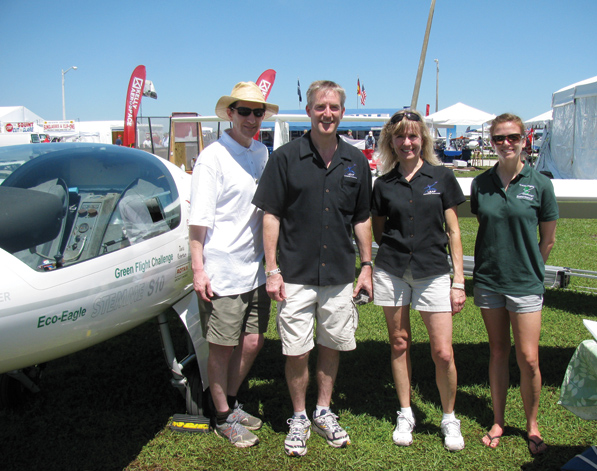
Morgan and Erik Lindbergh, Yolanka Wulff and Lisa Costello with ERAU Stemme S-10.
The Lindberghs, Embry-Riddle Aeronautical University and Hale Academy
Finding Embry-Riddle’s display of a jet-powered dragster fueled by a prominently labeled bio-go-juice, we turned to see the school’s Green Flight Challenge (GFC) competitor, a Stemme S-10 motorglider being converted to hybrid power by students.
Although the nose cone and engine bay were empty, graduate student Lisa Costello filled in future details. She explained that the original Rotax hybrid was set up to run the motor/generator continually, but that this unit will have a clutch operation and will use the motor only as needed for additional power. It will not recharge the 200 pounds of batteries nestled in the leading-edge wingroots. The cells will, however, provide power as needed to the electric motor and permit takeoff performance required for the GFC: The airplane must clear a 50-foot barrier at the end of a 2000-foot runway. It must also travel a 200-mile course around the Santa Rosa, California (Sonoma County), wine country at an average speed of 100 mph while achieving 200 passenger miles per gallon, Costello noted. It’s not a simple task to win the NASA/CAFE Foundation $1.5 million prize.
Originally envisioned as using a fuel cell/battery hybrid driving an electric motor, Eco-Eagle’s new Flight Design/Rotax system will burn Swift fuel to turn the unique MT retractable propeller. Use of the bio-derived fuel, not made with any food stocks, will enable the Embry-Riddle team to qualify for a $150,000 additional prize for most successful use of biofuels in the GFC.
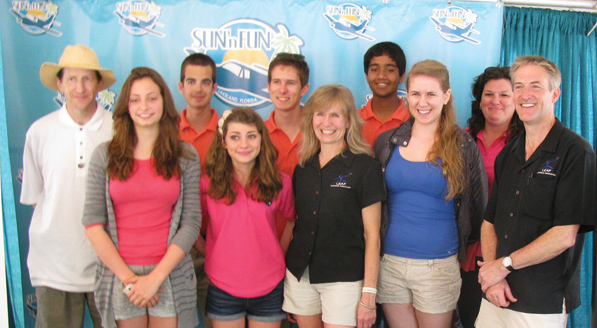
Morgan (far left) and Erik (far right) Lindbergh with Yolanka Wulff (center front), and Hale Academy Team Advisor Lorene De Aranzela at rest.
Costello guided us to a tent where Erik Lindbergh, Charles’ grandson, held a press conference announcing a new sponsorship by Sikorsky Aircraft (recently having revealed its electric helicopter, the Firefly) in the Lindbergh Electric Aircraft Prize (LEAP). Lindbergh also talked about the work with Embry-Riddle and with Hale Academy, a pre-K-12 private school in Ocala, Florida. Embry-Riddle students are performing the engineering and construction of their ideas, and Hale students, all high-school age, are making a documentary film explaining the problem-solving and design going into the finished product.
Lindbergh, along with his brother Morgan and LEAP co-CEO Yolanka Wulff, are enthusiastic about the students’ performance, and will stage a film festival of student-produced documentaries on different university projects in Seattle this fall.
Before that, Lindbergh planned to travel to Aero Expo at Friedrichshafen, where he would award the winner of the Berblinger competition (another green aviation event fielding 24 entrants) with a prize. He will also be part of the First Families of Flight program, uniting him with Sergei Sikorsky (son of Igor, who created the first single-rotor, mass-produced helicopter), Amanda Wright Lane (great-grandniece of airplane inventors Orville and Wilbur Wright), Wolfgang vonZeppelin (great-great-grandnephew of Count Ferdinand von Zeppelin, developer of the eponymous lighter-than-air ship), Bertrand Piccard (founder of Solar Impulse, captain of the first nonstop round-the-world balloon flight, and grandson of Auguste Piccard, inventor of the pressurized cockpit and stratospheric balloon) and Cornelius Dornier (grandson of flying boat innovator Claude Dornier). Prince Albert II of Monaco, already a backer of the Solar Impulse project, will also participate.
Costello and her ERAU team leader, Richard P. Anderson, gave brief talks on the Stemme GFC entry, followed by Hale students, who explained what they gained not only in filmmaking, but also in organizational and technical skills and understanding.
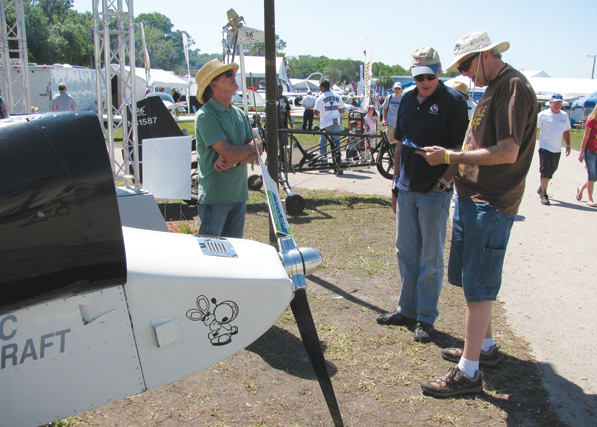
Randall Fishman discusses the ElectraFlyer C in the midst of the airshow.
Randall Fishman and the ElectraFlyers
The previous day’s tornado caused Randall Fishman to leave his two-seat Electra Flyer X back at the shop, a wise move considering the gumbo-consistency mud through which he’d have had to drag his trailer. He did have the ElectraFlyer C, a motorized version of the Monnett Moni, on display. Its Energizer Bunny-embellished cowling hid the 18-horsepower motor and controller. Fishman has sold those as part of the system, which includes instrumentation and a custom machined propeller hub, for the past four years. This is one of the few “plug and play” packages in the electric aircraft market today. Although Yuneec and Pipistrel are also fielding complete systems for original designs, Yuneec has delivered only its smaller paramotor systems, and Pipistrel has just announced the availability of its system, identical to the power system in its G2 Taurus Electro.
Fishman has a history of recognition for his efforts, including the Grand Champion Ultralight Award for his ElectraFlyer trike at AirVenture 2007. The ElectraFlyer C, which he displayed at this year’s show flew at the 2008 Oshkosh event and won the Stan Dzik Memorial Award for Design Contribution “for the installation of the Electric-Motor power train” and the Dr. August Raspet award that year. Fishman noted that previous winners of the Raspet prize are “a who’s who of aviation, and I was extremely proud to win it.” Still a milestone in electric flight history, Fishman’s four-year-old ElectraFlyer C took home an innovation award for the Light Sport class at this year’s show.
Fishman won the Lindbergh Aviation Grant in 2009 (not to be confused with the twice yearly LEAP awards or the AirVenture “Lindies”), and used those funds to build his ElectraFlyer X two-seater. In his application for the grant, Fishman listed the many advantages of electric airplanes, including the ability to site multiple small airports near metropolitan areas because of the small noise signature for such craft.
Discussing the status of the X, Fishman explained that he is working on a new motor prototype, a 9.5-inch diameter brushless unit that puts out 90 peak and 60 continuous horsepower. It’s a synchronous, three-phase, permanent magnet motor, one of three ranging from 30- to 90-hp peak outputs, 20 to 60 hp continuous.
The 20-hp unit runs on 75 volts, and the 40- and 60-hp motors on 144 volts. The largest weighs approximately 45 pounds. With CNC (computer numerically controlled) machined parts, Chinese rare-earth magnets, Japanese bearings and American stampings, Fishman’s motors will be truly international products. As he explained, “This is not pie in the sky for the future. The first two motors are completed and in my shop, ready for testing. The custom motor controllers are also complete.”
Fishman has numerous exciting projects, not yet available for discussion, but a personal one-off craft can be revealed. Seeing an electric blue Lazair in need of TLC, he bought it and has replaced the Rotax two-strokes with 12-hp motors. He looks forward to some personal flying time in this newly modernized ultralight. If you’d like one, you’ll have to build it yourself in this instance.
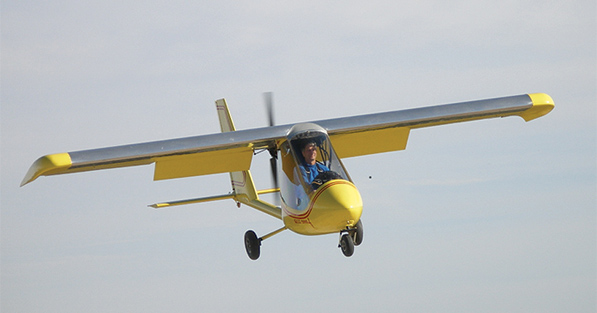
Mark Beierle’s Ultra Gull 2000 flying on one of its 11-minute trips with the original small battery pack.
Mark Beierle and HisElectric Gulls
Mark Beierle, owner of Earthstar Aircraft, has been designing and building ultralight aircraft for several years, and converted his UltraGull 2000 to power from a Perm 132 motor and Kelly controller mounted where the two-stroke Rotax or four-stroke HKS would normally reside.
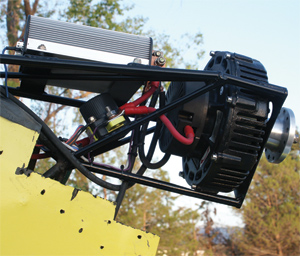
The Ultra Gull 2000 with PERM motor and Kelly controller as seen at Tehachapi, California, in 2008.
On his initial flights, he has reported breaking ground in 55 feet, climbing at 270 feet per minute, and being able to stay aloft for 11 minutes on a small lithium battery pack. He noted running at 4.5 kW at 55 mph when he first flew in 2009. Since then, he said, he has demonstrated two 45-minute flights at the Salton Sea (after replacing his original 20-foot wing with a 28-foot Soaring Gull wing), and is now working on his own ultralight motor, a 10-inch diameter, 16-pounder capable of putting out 20 kW (26.8 hp) and designed with the help of a German physicist. Beierle listed weights as 2 pounds for the iron in the motor, 3 pounds for magnets, with the remaining 11 pounds divided among bearings, copper coils and an aluminum housing.
Using 60 pounds of budget lithium cells from Hobby King, Beierle hopes to keep total power costs for his 28-foot span airplane to $6500. Compared to two-strokes, the long-term cost benefits might be on the side of electrifying flying, especially if battery prices continue to go down.
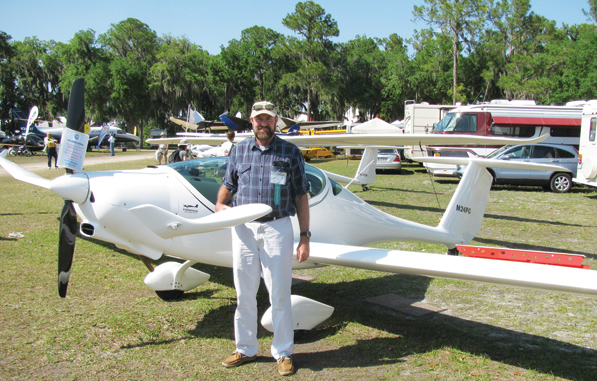
Jim Lee of Phoenix Air shows off the short wingtip of the Phoenix. The electric version will compete in the Green Flight Challenge.
Jim Lee and the PhoEnix
One of the first things we saw entering the grounds from the south was the swoopy Phoenix SLSA motorglider, a product of the Czech Republic and pretty enough to be featured on the 37th Annual SNF poster along with the Blue Angels, among others. An electric version of the airplane is scheduled to compete in the Green Flight Challenge, and like all GFC participants, Jim Lee, the airplane’s U.S. distributor and its pilot for the 200-mile Challenge, was reticent to share too many details. For now, imagine the current Rotax-engine airplane as the PhoEnix, a more pointy-nosed version of what’s shown here, with some additional aerodynamic enhancements to make it even more slippery. The Rotax version, with propeller feathered, claims a 32:1 lift-to-drag ratio, and PhoEnix will be good for 36:1.
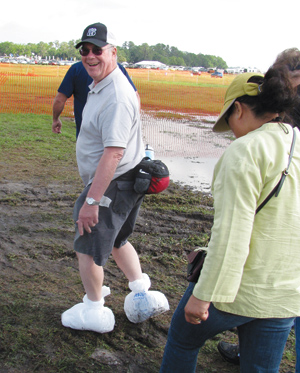
An enterprising soul trudged through the gumbo-like muck of the SNF parking area dry shod.
Lee showed off the short wingtips that make the airplane into a straight LSA, just a little faster and stronger than the motorglider’s long-wing extensions will allow. He explained that the airplane comes with both wingtips, giving the prospective buyer a versatility of flight most airplanes cannot provide. Additionally, a buyer will not need to remove the entire wing to fit the Phoenix into a standard T-hangar.
Lee did say the GFC model would be powered by a 44 kW motor and controller being developed in house by Phoenix Air, the Czech designer and builder. Current will flow from commercially available lithium polymer batteries. If one needs convincing as to the airplane’s flying qualities, watch the video link included, with Lee showing off his flying skills and an approach to a night landing. The video was shot with a compact 720p high-definition camera, and the images are stunning.
Lee made a sale during the show, at least partly because Phoenix’s inviting cockpit wins over wives, he says, and he had additional happy news in the form of the award for the Outstanding Fixed Wing Light Sport Aircraft.
Disappointment andEncouragement at Once
OK, I admit to a little disappointment that the Green Aviation site was not overrun with new models and exciting new technologies. Blame the storms and the upcoming Green Flight Challenge for that. Because I blog for the CAFE Foundation, I’m not blaming them, but rather reporting the need for competitors not to show their hole cards until the big event. Doubtless some were not ready to reveal their winning hands so publicly yet.
Others are finding the electric aircraft more problematical than it looks. Note that groups that made big announcements and unveilings in the last two years have not come up with sales or deliveries. An exception to that may be Pipistrel, which reports sales of 40 units of its new G2 series Taurus Electro. The company is selling its complete power package, too, with motor, controller, battery management system (BMS) and batteries. This system is ready to install in an OEM project, according to the Slovenian factory. We are still awaiting delivery of Yuneec’s line (other than powered parachutes) into customers’ hands.
Things are ready to pop, though, and several breaking news items, which I’m not able to divulge at this time, are about to change the scene in fairly significant ways. As this is being written, the fifth annual Electric Aircraft Symposium in Santa Rosa, California, is drawing near, and there should be some blockbuster announcements there.
In the meantime, keep an eye on the young people, the most enthusiastic bunch I’ve ever seen, as they provide design, building and documentation skills that will enliven the green flight scene. As Erik Lindbergh said, “These kids are the real story.”
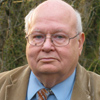
![]()
Dean Sigler has been a technical writer for30 years, with a liberal arts background and a Master’s degree in education. He writes the CAFE Foundation blog andhas spoken at the last two Electric Aircraft Symposia and at two Experimental Soaring Association workshops. Part of the Perlan Project, he is a private pilot, and hopes to get a sailplane rating soon.

